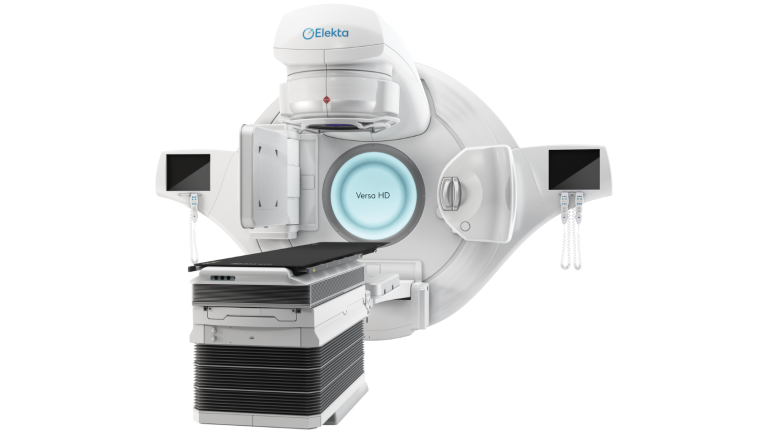What is the Linac Device? In Which Diseases Is It Used?
The LINAC device is a high-tech radiotherapy device that can apply high-energy X-rays or electrons, i.e. artificial radiation, at different angles and durations according to the shape of the targeted tumor area, while protecting the surrounding healthy tissue.
These devices can be used for radiotherapy of almost all tumors that can be observed in any part of the body, mainly in the lung, prostate, breast, bone, brain, liver, skin, head-neck and abdominal organs. The aim of radiotherapy is to neutralize cancerous tissues with maximum radiation dose while minimizing the radiation dose to healthy tissues in the surrounding area, in other words, to complete the treatment with no or minimal side effects. In summary, a balance of benefit and harm must be observed.
How is Treatment Planned? How is it Implemented?
The radiation dose and the number of treatment sessions are decided by the radiation oncology specialist. The type of treatment, technique, radiation dose and total treatment duration may vary depending on patient and tumor characteristics. In the treatment, X-rays or electrons are applied externally to the targeted area without any surgical or interventional procedure.
In treatment planning, the artificial X-ray beams created on the LINAC device can be applied at different angles for different durations and are tailored to the shape of the tumor in 3D. On the other hand, with the help of the medical imaging capabilities of LINAC devices and various software, both the target areas and the surrounding healthy tissues are observed to ensure that the treatment is applied to the right area under appropriate conditions and the possibility of side effects is minimized.
Only the patient is present in the treatment room. The treatment room is designed specifically for the treatment device used in accordance with world standards and is armored to prevent radiation leakage to the outside. Radiotherapy technicians remotely monitor the patient throughout the treatment by means of monitors in the control room where the console of the device is located. In the meantime, they control the device, stop the treatment when necessary and report any unusual situation to the medical physicist and radiation oncology specialist physician.
Is Pre-Treatment Preparation Necessary?
After the specialist physician decides on radiotherapy for the patient, the stages of preparation for radiotherapy are carried out respectively in accordance with the planned treatment.
First of all, patients are informed verbally and in writing about the procedure to be applied. Treatment efficacy and side effects are explained and patient consent is obtained. Hygiene, lifestyle and nutrition recommendations are made before, during and after the treatment.
Then, simulation and immobilization (fixation) stages are started in accordance with the treatment to be applied. Computerized tomography is taken for planning purposes and immobilization tools suitable for patients are determined. For example; thermoplastic head-neck mask for head-neck and brain tumors, lung plane for lung and intra-abdominal tumors, breast oblique plane for breast tumors, knee-elbow pillow, foot pillow, vacuum mattress, etc. can be used in many irradiations. The critical point at this stage is that the patient should be able to stay in the same position during each treatment. Therefore, positioning and stabilization should be repeatable and comfortable. Depending on the treatment, bowel/bladder fullness and hunger/fullness may vary. Patients are also educated about these issues when necessary.
After the simulation images are taken, the contouring and planning phase begins. The data obtained with simulation tomography is transferred to the contouring and planning computers. Tumorous tissues and healthy tissues at risk near the treatment area are drawn one by one on the tomography sections. Mapping (fusion) with MRI or PET/CT images can be performed while targeting. This allows more accurate and precise identification of tumors and organs at risk. Taking into account tumor characteristics, radiation tolerance of healthy tissues at risk and patient characteristics, treatment plans are created by medical physics specialists.
Among the plans created, the plan that is most advantageous for the patient, where the dose to which healthy tissue is exposed is the lowest while applying the therapeutic dose to the target, in other words, the possibility of side effects while controlling the tumor is the lowest, is selected by the specialist physician.
After the quality control tests of the selected plan are completed, the patient is given an appointment for the first treatment (setup) day. Before the treatment is given, a snapshot is taken and matched with the images on the simulation tomography. If necessary, appropriate corrections are made by the radiotherapy technician and the patient is precisely (millimeter) positioned. During each treatment session, the patient is checked and the correction process is repeated if necessary.
How long do the treatments last?
In modern LINAC devices, traditional treatments are applied every weekday, i.e. 5 days a week. Each session lasts approximately 15-20 minutes for one session a day. In addition, stereotactic, or pinpoint treatments, which are also frequently used in clinical practice, can be applied every weekday, 2 days a week or 3 days a week, depending on the disease. Compared to conventional treatments, stereotactic treatments have a much higher daily dose but a shorter total treatment time. Daily sessions can last between 30-45 minutes on average.
What are the Side Effects?
Some side effects may occur during or after treatment. Side effects are usually only observed in the area treated with radiotherapy and can usually be controlled with medication. Different side effects may be observed depending on the area treated. The best approach would be to consult with the radiation oncologist who planned your treatment for side effects.
The importance of early diagnosis in saving lives should not be ignored. It is important to have your annual check-ups and to meet regularly with your doctor. You can make an appointment at Hisar Hospital Intercontinental, Department of Radiation Oncology to discuss treatment methods with a specialist radiation oncologist and to get information about treatment options with the LINAC device.


